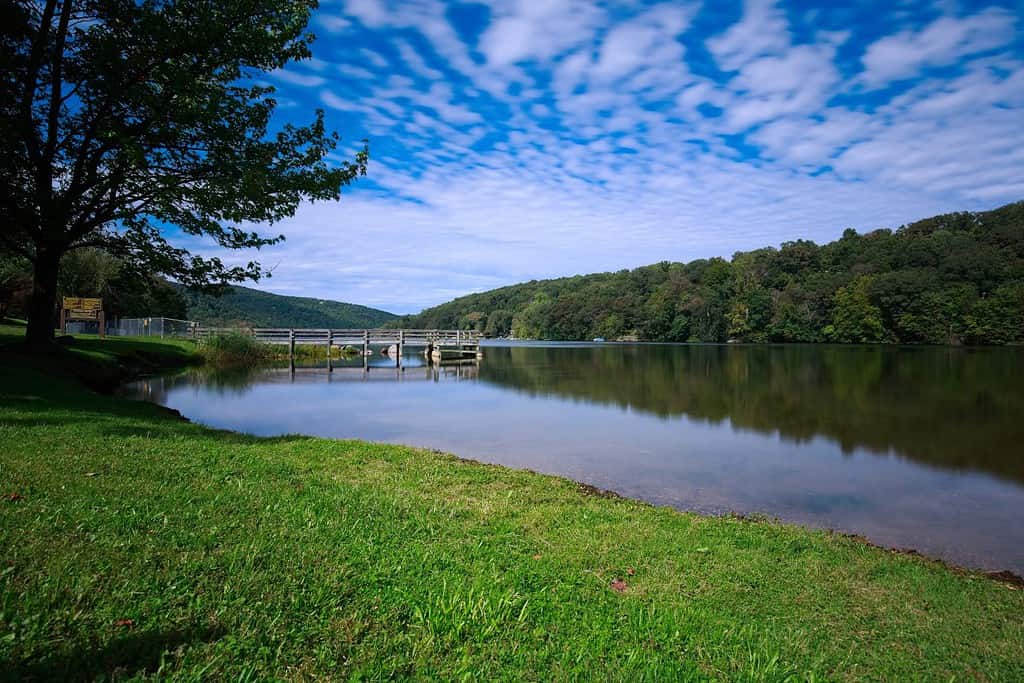Are you thinking about taking your pug for a swim?
Pugs have been a popular household pet for hundreds of years. Some theories suggest their name comes from the pug monkey or marmoset monkey, a popular house pet in the 1700s. Today these pint-sized pooches are still winning over hearts across the world. With their square-shaped body, adorable wrinkly faces, and big bulgy eyes, pugs are the ultimate companion dog.
In this article, we’ll be exploring whether or not pugs can swim. And if they can, what precautions should you take? Read on to find out what these canines are capable of.
Can Pugs Swim?

Pugs can swim but their stocky bodies make it difficult to swim for long periods.
©220 Selfmade studio/Shutterstock.com
Yes, pugs can swim. However, they’re not as skilled as water dog breeds, such as labrador retrievers. Pugs have all of the motivation and desire to swim, but their body makes it tricky to move with grace. It’s difficult for pugs to keep their large heads above water. And their broad chest and short stubby legs don’t help much either. That’s why many pugs prefer to stay in shallow water, where they can splash and play with ease. Personalities also vary from one pug to the next. While one pug might love the water, another may want nothing to do with it.
1. Bring a Friend
Bring a dog friend with you for your swimming lesson. If your pug sees another dog having a good time swimming, they’re more likely to give it a try themselves. Choose an older dog that you already know your pug gets along with. Then choose a spot where you won’t be disturbed. If you’re going to a public swimming area, pick the quietest spot. The fewer distractions, the better.
2. Check the Water

Check the temperature of the water before letting your pug take a dip.
©mjbdesignworks/Shutterstock.com
If you come across a pond, and you’d like your pug to take a dip, hold off a second. You’ll want to know the temperature of the water first. If it’s too cold your dog could get hypothermia. You’ll also want to be aware of the other creatures that might be swimming too, like snakes and snapping turtles. For a more controlled swimming experience, consider buying a small plastic pool.
3. Use a Life Jacket
Use a life jacket the first time you take your pug to swim. This will help them get the confidence they need to try swimming again, while also preventing drowning.
Life jackets can be used for every swimming session if they’re needed. Some pugs have trouble paddling and the buoyancy of a life jacket makes swimming more enjoyable. This is especially true for older dogs who might not have the energy to swim unassisted.
4. Be Patient

Create a positive experience by staying calm and patient during your pug’s swimming lesson.
©Africa Studio/Shutterstock.com
Some pugs are instantly comfortable and excited to be around water. Others may need a little convincing. If you’re introducing a puppy to the water, be patient. Positive reinforcement is a big part of the learning process. Bring plenty of small treats and be sure to offer praise every time they wet their feet. Once your puppy starts to look tired, it’s time to take a break.
5. Understand the Breed
If you’ve trained a different breed of dog to swim before, that’s great. But don’t expect to have a similar experience when teaching your pug the same skills. Certain breeds are born to swim, like Irish water spaniels, retrievers, and Portuguese water dogs. These dogs have an anatomy that makes it easy to swim, so they can paddle the day away. Pugs don’t have this type of endurance. Their anatomy makes swimming tiresome.
6. Never Pull or Throw a Dog Into the Water
Never throw your pug into the water. This can be startling and make them have negative fearful associations with swimming. Instead of throwing or pulling, it’s your job to convince your pug that going in the water is a good idea. There are a couple of ways to accomplish this task. You can try going in the water yourself and calling them to you. You can also try using small treats to encourage them to put their paws in the water. As we mentioned in the first tip, bringing another dog who loves swimming can also help.
7. Use Small Treats

Opt for small tiny treats when encouraging your dog to swim.
©Kamix-studio/Shutterstock.com
Use small treats when training your dog to swim. Make sure the treats are so tiny so that they’re easy to eat with one bite. You don’t want your pug struggling to eat a big snack at the same time they’re trying to swim. And don’t forget about praising your pug too. Verbal encouragement can be just as tasty as a biscuit.
8. Provide Clean Drinking Water
Swimming takes a lot of energy, which means your little pug is going to get thirsty. Be sure to have clean drinking water available so they’re not tempted to drink from the water they’re swimming in. Finally, keep an eye out for signs of dehydration.
9. Stay Close to Your Pug
Stay within arms reach of your pug. If they go in the water, go in with them. That way you’re always nearby if they need a quick escape. Start in shallow water and gradually work your way toward deeper waters. If your pug seems anxious or overly excited, encourage them to come back to the shallow water. Here they can get their bearings before venturing out into the deep again.
10. Keep Sessions Short

Keep swimming sessions short and allow plenty of time for your pug to rest afterward.
©fongleon356/iStock via Getty Images
When teaching your pug to swim, be careful to not overdo it. It’s easy for your pooch to swallow water as they attempt to keep their head up. And if they swallow too much water they might become sick and start throwing up.
A five to 10-minute session is plenty long for introducing your pug to the water. During that session, allow time for breaks. If your pug loves the water, you can schedule more than one lesson per day. Just be sure to allow plenty of time for rest between lessons.
The photo featured at the top of this post is © Africa Studio/Shutterstock.com
Thank you for reading! Have some feedback for us? Contact the AZ Animals editorial team.






